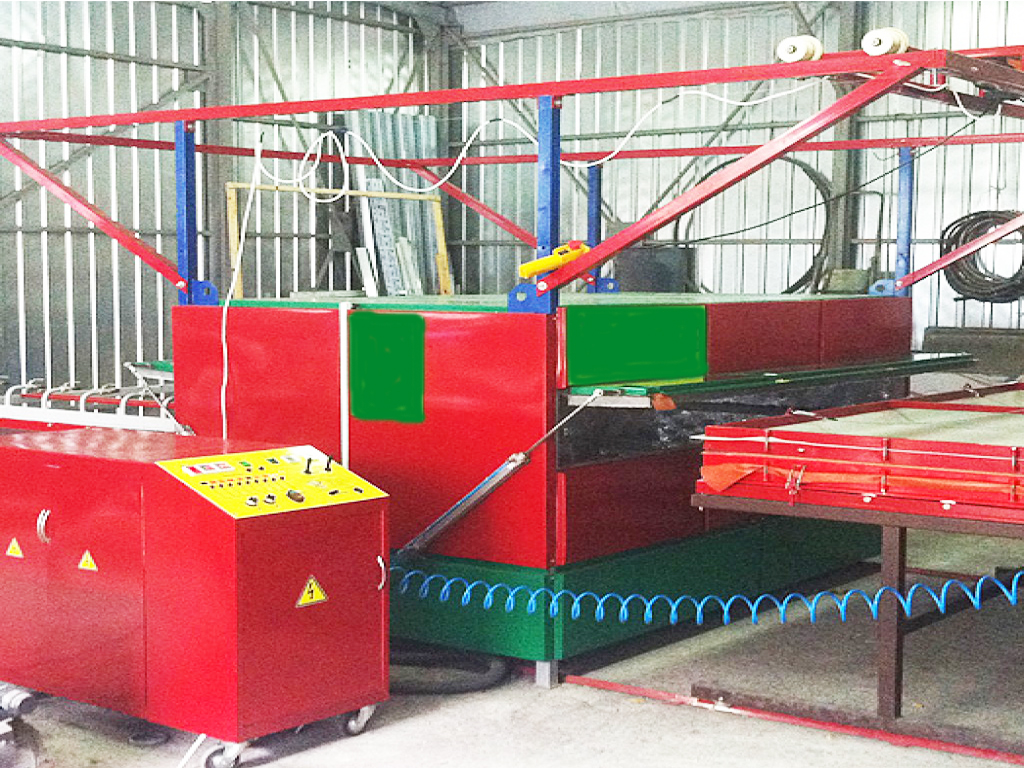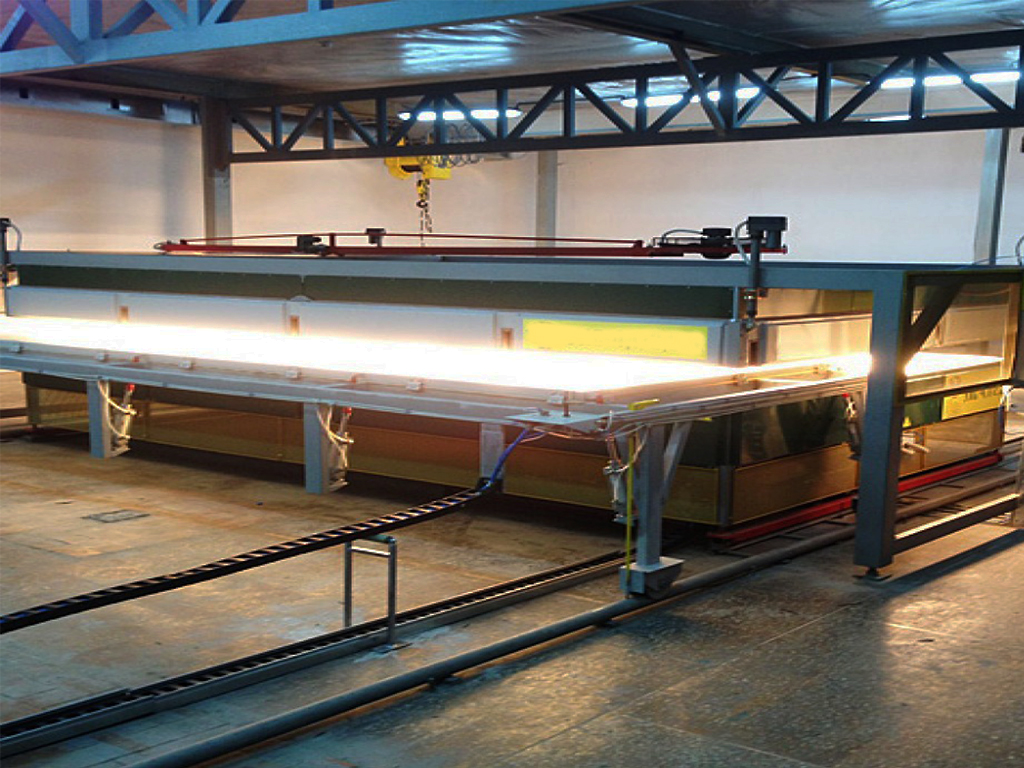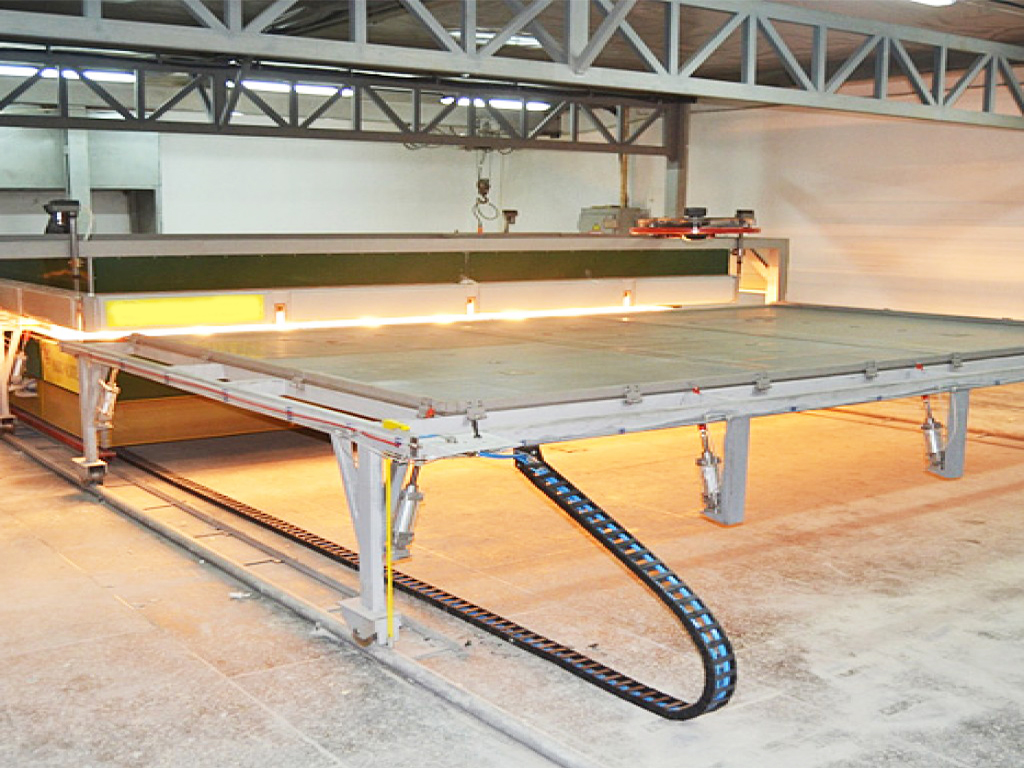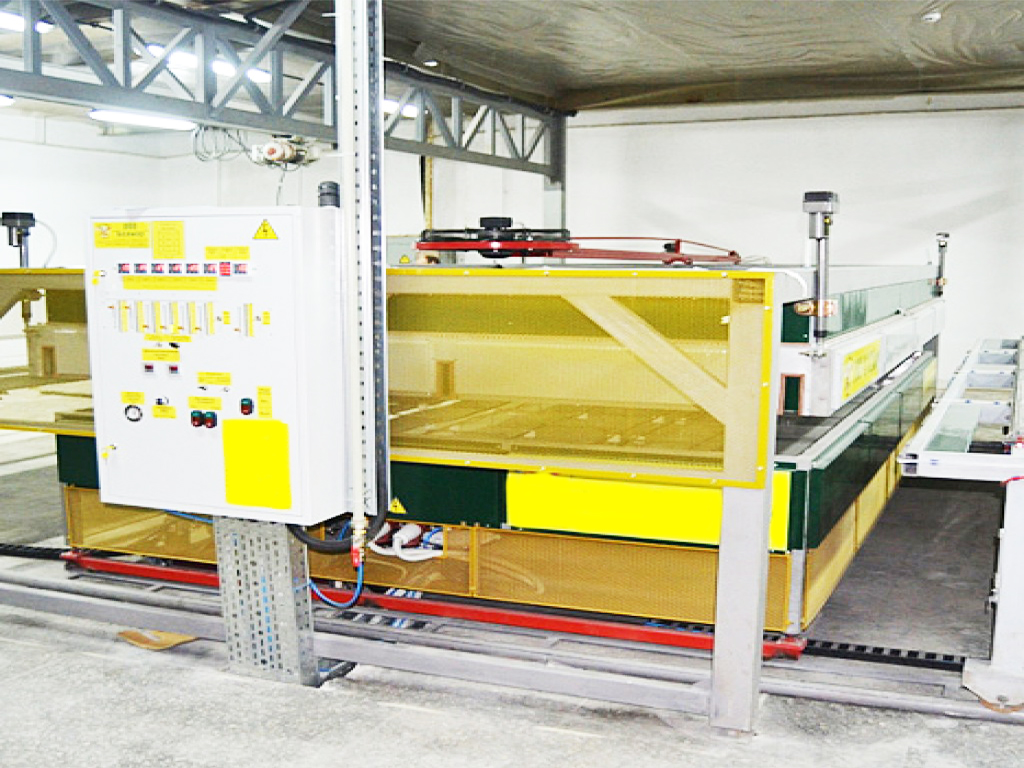Glass Laminating Furnace (Triplex, Polyplex Glass)
Plate architectural glass has been found as application area for many years. During this period, manufacturers have made significant progress in production and processing technology and have revealed almost all of their characteristics and qualities. The development of glass by using nano technology has opened new horizons for architects and designers, increased the performance and esthetic qualities of glass. We would like to point out that multi-layer safety glass (laminating glass) is one of the most important developments as a structural material in all the structure and properties of glass. All the operational and technological features of such glasses, principle of sandwich structure, that is, an intermediate polymer layer and a heterogeneous structure within the composite, have brought significant innovations and advantages in the industry.
Today glass can be perceived as a basic building material like metal sheets, concrete, that is used in building constuctions. Unfortunately, in the technology of layered (triplex) glass production, new machinery and production technologies are not adequately researched. In this context, production in the triplex glass sector is done by old methods. Researchers have difficulties in improving the technology and equipment to create laminated glass (triplex) that are out of attention.
First; the formation mechanism of the glass, the technology of layered glass and the existing strength properties should be examined. Afterwards, integration of polymer materials which are new and more resistant than the old ones into this sandwich panel should be investigated.
The combination of brittle glass and plastic material (eg polycarbonate glass, sandwich glass, acrylic glass block, and others) optimizes the properties of laminated glass. There will be no doubt that further development of existing products through the development of research in these areas and the development of new approaches in device design and construction for industrial production of laminated glass will be encouraged. Thus, laminated glass, layered glass, triplex glass will focus on the traditional definition, without taking differences in scientific and technical interpretation:
Lamination; glass, liquid or film with the help of polymer materials, smooth or curved glass glued onto the entire surface of a stable joining method.
Currently, two technologies are used in the world for the production of laminated glass. First, the glass is glued to each other at high temperatures and pressures using polymer film.
Liquid casting technology does not take up too much space in the general segment of safety glasses due to technological and operational limitations in glass production.
Glass film technology is divided into two groups: autoclave and non-autoclave. Both processes are based on the same physical principles. The differences are related to the outline and sequence of technical operations.
Sheet-layer glass producers prefer non-autoclave technology for economic reasons. In addition, the emergence of new films increases the use of non-autoclave triplex technology for architectural purposes. Particularly in tampered and bended glass.
Unfortunately, the disadvantage of both technologies is that they give error rates of 10-15% from production. The main reason for the high error rate of such products is low quality of adhesion between the glass sheets, bubbles are formed.
Therefore, the most important improvement activity in the production of laminated glass is to increase the consistency and strength of the polymeric materials and the entire contact surface of the glass. Briefly; it can be called both for the design of equipment and for the safety laminated glass, the definition of optimization of production processes.
Adhesion depends on the chemical nature of the polymeric materials forming the multilayer glass composition. In addition, assembly / package, pre-discharge stacking, washing and drying, vacuuming etc. are very important in terms of adhesive contact formation. However, as practical studies show, the main reason of errors is thermo process. This is due to the thermal physical properties of the glass, so that when the heat is applied to the layered glass, the same heat values are not generated on all sides of the glass, e.g. In simple combinations, homogeneous heat dissipation is easier in the glass-polymer-glass composition, while it is much more difficult to achieve homogeneous heat distribution in layered glasses such as polyplex.
In the last 10-15 years, theoretical and applied monographs, articles and questionnaires were discussed. In these studies, more attention was paid to hardening, strengthening and flexibility of sheet glass and optimization of heat treatment.
Generally, it is very difficult to choose the appropriate equipment / machine for the heating of a multi-layer composition (in particular big sizes) and the appropriate regime, due to the physical properties of the glass. It should be noted that today’s old methods, are losing their places because of the problems. Infrared heating technologies are becoming more and more involved in the glass laminating sector.
In the selected areas of the surface of the object exposed to the IR beam, there is a significant increase in the heat flow density, so the heat input rate must be controlled. The use of IR radiation in deep penetration into the material improves many technological processes of heat treatment. Efforts have been made to replace existing convection systems with IR furnaces, but the major obstacle is the inadequacy of theoretical theses and research on glass lamination, which makes it difficult to develop.
There are objective requirements for solving scientific and technical problems:
In order to increase the production efficiency of multi-layered architectural glass, it is necessary to develop a series of measures and methods, in order to achieve a uniform heat dissipation throughout the entire surface of the polymer sheet between the glass and to achieve a better homogenous heat dissipation regime, to reduce the error rates and to produce quality products.
İSSUES TO BE INVOLVED FOR THE OPERATION OF GLASS LAMINATION:
- Understand the physical properties of interactions in the glass-polymer interface under conditions of formation of an adhesion between glass-polymer (at temperatures above 100 ° C);
- Thermal properties of glass in thermal processes. The thermal-physical properties of glass exposed to radiation in the spectral range of 0.8-2.0 μm and the nature of the heat distribution within the glass itself;
- To develop a technique for monitoring and controlling the homogeneous warming of all layers of the layered glass. It is necessary not only for the upper and lower layers but for the heat to be transmitted in a homogenous manner in the middle layers, and to ensure the energy flow density.It is necessary to find technological and design solutions to ensure high processing efficiency by significantly reducing the time and energy consumption to ensure that the laminated glass is heated quickly and smoothly with all layers;
- Synthesize the most appropriate heat control law in the heating of laminated glass;
- Development of tools for stabilizing the regime parameters and controlling the dynamic fashion of lamination.
The process of optimizing thermal engineering in the production of laminated glass was previously considered. The solutions in production enabled us to develop some practical suggestions to improve the properties of the heat treatment process.
However, until now, a holistic methodology has not been developed with a single regime criterion. Working regimes need to be adjusted when changing the results of practical work in domestic and foreign laminating ovens, passing machine installations from one glass article to another, or changing the type of intermediate polymer film. Laminated plant operators choose from either regenerative technology regimes recommended by film manufacturers, or their own experience. Because the manufacturer’s instructions remain superficial, the operators are creating their own regimes. As a result, the error rate increases, in addition to practical experience, the selected heat treatment modes are generally not the most efficient mode.
As a result, all these factors negatively affect the cost and quality requirements of the products. Equipment manufacturers should provide a detailed and descriptive physical instruction for all these. Ex; let us think about powder coatings. They are divided into two main groups as thermoset and thermoreactive.
The processes in the paint technology are clear: to form a coating, it is said that the product is allowed to stand for a period of time specified in the instruction.
There is no waiting time after reaching a certain degree for thermoplastic paints. In a complex combination of glass-polymer-glass-film when laminating (as a rule, a silicone membrane of at least 4 mm thick) is used; In a simplified manner, the lamination process is reduced to the bonding procedure, the adhesive is heated by heating the film and adhered to the pressure.In addition to the basic design concept, the selection and justification of the rational modes of IR energy in lamination technology was studied on a specially developed IR type industrial unit using low inertia linear, quartz and infrared sources.
General view of the oven
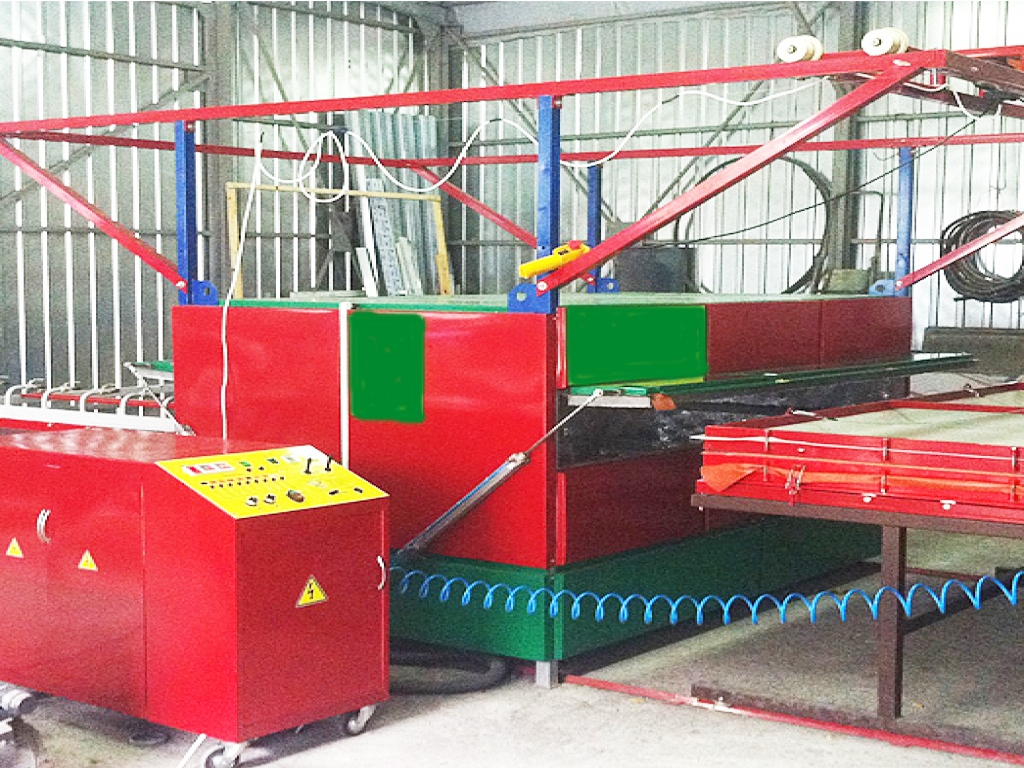
Considering portable design (within the framework of assumptions) in analytic way, the configuration of designs, geometric dimensions and reflective screens, we attempted to associate the IR emitters with the layout of the whole plant to solve the problem of radiant heat exchange.
ANALYSIS OF RESEARCH RESULTS
- The temperature of the heated object is homogeneous; The position of the heating source (depending on the material) depends on the distribution of the heating source and the distance between the heating source and the surface of the object.
- The distance between the heating source and the surface of the object is determined by the step ratio between the sources.
- When using the upper and lower heating sections, the IR sources must be combined into thermal blocks and cross-radiation propagation must be ensured.
The second problem to be overcome is; Heat dissipation of infrared radiation, the boundary conditions and constraints given by the temperature gradient along the thickness of the laminated glass (temperature values given by the manufacturer of the polymer material) to achieve optimization of the heating speed of the layered glass. Rapid heating of the glass sheet (which causes the polymer to boil when it exceeds the temperature of the polymer in the laminated furnaces and disrupts the structure of the polymer) disrupts the structure of the polymer in the intermediate layer. The slow heating of the glass sheet reduces the temperature differences between the polymer and the glass layer, but leads to loss of capacity as it prolongs the baking time. The fact that the polymer is not fully heated increases the error rates in production. The following contradictions arise when optimizing the dynamic heating modes of the composite structure.
- The recommended processing temperature of the polymer must be the same,
The temperature gradient should have a certain value.
As a result, we can sort the process of controlling the dynamic mode of infrared heating on the sandwich glass as follows:
- Choosing the right energy flow density,,
- Selection of the correct temperature values (proportional to the power from the radiation source),
- Choosing the right curing time,
- Optimal distribution of radiation sources and the correct choice of distance between the source and the material,
After the right selection, we can perform the optimal curing process of the sandwich glass-polymer layer.
One way to solve the problem is the oscillation regim of IR lamps in accordance with the layered composite glass and polymeric materials (Auto control of the lamps, the lamps are turned on for a certain period of time, the heat from the radiation starts to disperse in the material, the lamp is turned on again and the energy is delivered to the mountain in deep layers.)
In connection with the need to measure and adjust the temperature of the glass sandwich, an information measurement system was developed to control the oscillatory regeneration, thereby maintaining the maximum and minimum temperature of the material.As a result of our studies, we have developed a system that can control temperature in every section of the product by using infrared radiation.
GLASS LAMINATION ULS-4,1 / 2,5 IR
(see photos and features)
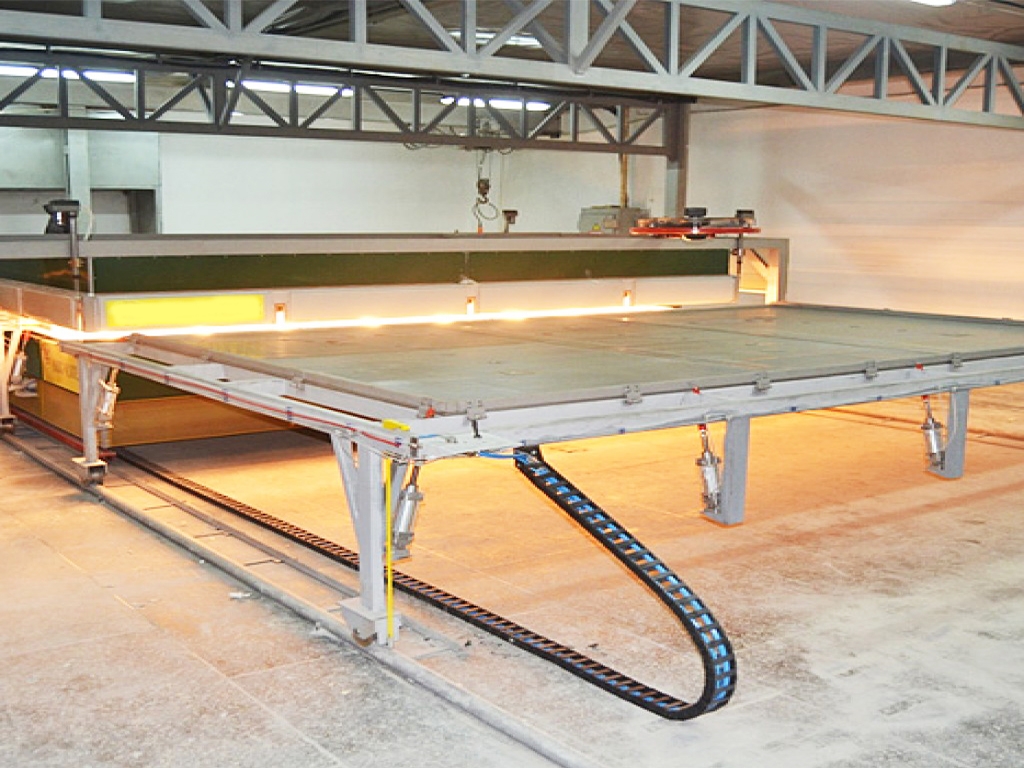
AİM:
- Production of film triplex using vacuum laminating method;
- Glass, MDF, Metal decoration;
- Triplex-glass block production;
- Decorative triplex production.
HEATING METHOD:
- IR radiation.
“Glass-Film-Glass” operates according to the principle of programmable infrared heating.
BASIC FEATURES:
- Computerized intelligent temperature control system for heating the entire product;
- Integrated vacuum table leveling system – prevents deterioration during operation;
- Automatic system for maintaining the vacuum in the vacuum system within the limits provided by the operator;
- Automatic adjustment of the power of the heaters depending on the temperature in the heating chamber (PID controller);
- Independent upper and lower heating sections;
- Electronic control of the vacuum system with digital display;
- Used vacuum pump type: Rotary plate, oil-insulated;
- The capacity of the vacuum system, m3 / h – 63;
- Membranes used: heat resistant silicone (two canvas 4 mm thick);
- Technological cycle method used; Continuous;
- Considering the operating modes, lamination and decoration processes for various algorithms:
- Automatic;
- Semiautomatic;
- Manual;
- The overall dimensions of the table are 4300 × 2500 mm;
- Number of work tables – 2;
- Type heating elements – KGT type IR sources with diffuse reflectance;
- Maximum heating temperature: up to 200 ° C;
- Maintain the temperature on the surface of the product during the operation temperature and
the set temperature protection phase: (±) 2-3 ° C; - Pressure in lamination, kg / m² – up to 9700;
- Cooling of products: compelling air;
- Ionomeric Adhesion, Possibility of Using Polymeric Materials – SENTRY GLASS;
- Power consumption: 60 kW;
- Maximum load capacity at one time, m² – 10.25;
- Weight, kg – 2000;
- Controlled parameters:
- Rareness;
- Two-axis temperature gradient;
- The time of each operation;
- Absolute temperature.
- Film type used:
- EVA; PTI; SENTRY GLASS;
- THERMOPLASTIC POWDER PAINT.
- The maximum thickness of the treated glass is – 30mm;
- Number of controlled heating zones – 12;
- Vacuum number – 2 pcs.;
- Laminating temperature: 100-150 ° C;
- IR sources of the upper zone can be controlled separately;
- The upper and lower portions of the IR emitters are provided with oscillation regime systems;
- The inner surfaces of the installation are covered with a special material which provides a common reflection;
- Glass varieties used for lamination:
- Colorless float glass;
- Mass color;
- Tempered;
- Enamelled glass.
- Installation performance at full load:
*The average cycle performance for 4 × 4 packets is 30 minutes..
Lamination machine Model ULS-4,1 / 2,5 IR, different film types of glass work with lamination quality and energy consumption good results were obtained.
To summarize, infrared (IR-short wave 0.78-2 microns) in the production of layered glass, the first time in this sector of heating with oscillation regime has been used and efficient results have been obtained by us.
İn order to increase the quality of laminated glass production in infrared furnaces, there is a need to find answers to the questions below:
- The adhesion properties of the films used between glass and polymer need to be standardized.
- Development of mathematical modeling and engineering calculation methodology of IR installation;
- Effect of material and pressure on IR heating kinetics and investigation of optical properties.
- Evaluation of the effect of pretreatment processes on glass and polymer surface before lamination;
- Investigation of the effect of IR heat transfer on glass surfaces and coatings applied to glass types used in heat treatment process.
Continuing work in this direction will lead to more accurate practical advice, thus reducing the percentage of faulty products and improving the quality of the laminated glass produced.

